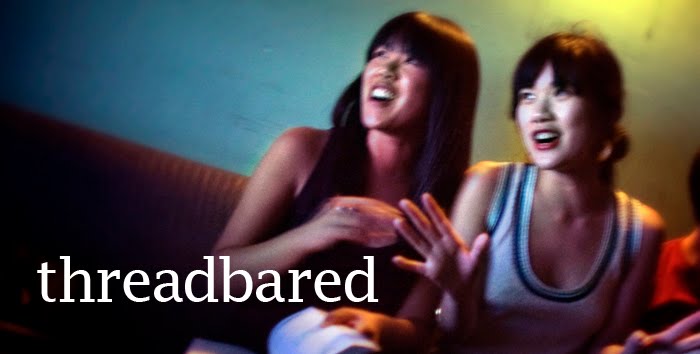 Dean Spade is a genius activist lawyer and legal scholar. (For instance, he is the founder of the Sylvia Rivera Law Project, a non-profit law collective that provides free legal services to transgender, intersex and gender non-conforming people who are low-income and/or people of color. And just look at this photograph! In other words: CRUSH-WORTHY.)
Dean Spade is a genius activist lawyer and legal scholar. (For instance, he is the founder of the Sylvia Rivera Law Project, a non-profit law collective that provides free legal services to transgender, intersex and gender non-conforming people who are low-income and/or people of color. And just look at this photograph! In other words: CRUSH-WORTHY.)In his essay "Dressed To Kill, Fight To Win," published in the first issue of feminist genderqueer collaborative arts zine LTTR, Spade challenges the notion that undergoing or adopting certain bodily practices preclude a person from a "rational" or radical political position.
Against discourses of the authentic, real, or natural, he challenges the notion that persons who change their appearances, their bodies --with commodities, with clothes, with surgeries-- are necessarily duped or self-hating; he further argues that there is no necessary or singular correlation between one's aesthetic practices and political commitments. (In the most familiar "dilemma" of this sort, can a feminist wear heels? In another, does a femme have to? And yet another, can a feminist wear hijab? Answers: Yes, no, yes. You get the drift.)
Although Spade writes about trans surgeries in particular, his analytic cautions are useful for thinking through other bodily practices in general and --yes, this again-- the unreliable stories these tell about our psychic interiors or political convictions.
I love this last paragraph, in which Spade is critical of perspectives that assign to bodies "natural" qualities or "real" characteristics that are proper to them, which assumes a fiction of "whole" or "neutral" body as a disciplinary and normative ideal. He instead asks us to consider how such a stance assumes a "superior" perspective that erases or dismisses other modes of explanation or engagement with these bodily practices.Does it matter what I’m wearing, what I look like, how I wear my body? All our lives, we receive conflicting commands to ignore appearances and not judge books by covers, and to work incessantly to conform our appearances to rigid norms. The result, I think, is that as we come to reject and unlearn the ways we’ve been taught to view our bodies (fatphobia, racism, sexism, gender rigidity, consumerism, ableism) we become rightfully suspicious of appearance norms and fashions and seek to form resistant practices. But what should those resistant practices be?
I think sometimes being anti-fashion leads to a false notion that we can be in bodies that aren’t modified, and that any intentional modification or decoration of your body is politically undesirable because it somehow buys into the pitfalls of reliance on appearances. This critique is true, lots of times what we mean to be resistant aesthetic practices become new regulatory regimes. Certain aspects of activist, queer, punk fashions have fallen victim to hierarchies of coolness that in the end revolve around judging people based on what they own, how their bodies are shaped, how they occupy a narrow gender category, etc. Perhaps it is inevitable that the systems in which we are so embroiled, which shape our very existence, should rear parts of their ugly heads even in our attempts at resistance. But does this mean we should give up resistant aesthetics? Isn’t all activism imperfect, constantly under revision, and isn’t that why we continue doing it? In my view, there is no "outside"-none of us can stand fully outside capitalism, racism, sexism and see what is going on. Instead we stand within. and are constituted by these practices and forces, and we form our resistance there, always having to struggle against forces within ourselves, correcting our blindspots, learning from one another. So of course, our aesthetic resistance should do the same.More importantly, when we appeal to some notion of an unmodified or undecorated body, we participate in the adoption of a false neutrality. We pretend, in those moments, that there is a natural body or fashion, a way of dressing or wearing yourself that is not a product of culture. Norms always masquerade as non-choices, and when we suggest that for example, resisting sexism means everyone should look androgynous, or resisting racism means no one should modify the texture of their hair, we foreclose people’s abilities to expose the workings of fucked up systems on their bodies as they see fit.
(For example, Kathleen Zane writes in her essay on certain cosmetic surgeries: "Understanding how, for non-privileged classes of women, forms of personal power or ways to manipulate disadvantageous social circumstances can be creatively engaged, we may confront the power and privilege that accrue from our espousal of our particular oppositional strategies." From “Reflections on a Yellow Eye: Asian I (\Eye/)Cons and Cosmetic Surgery,” in Talking Visions: Multicultural Feminism in a Transnational Age, edited by Ella Shohat.)
Instead of condemning cosmetic or trans surgeries, straightened hair, hijab or high heels as "unnatural," we would be better served as feminist theorists of culture to ask: Which kinds of bodily practices are normalized as "appropriate" to feminine persons, and to masculine persons, and how? What values (of race, nation, gender, economic status) do these practices normalize? What ideologies are embedded in these often-literal inscriptions upon differentiated bodies? How have these discourses and practices changed in historically and culturally specific ways?
Spade ends his essay with this utopian note about the look of radical possibility:
So a part of this fashioning we’re doing needs to be about diversifying the set of aesthetic practices we’re open to seeing, and promoting a possibility of us all looking very very different from one another while we fight together for a new world.



